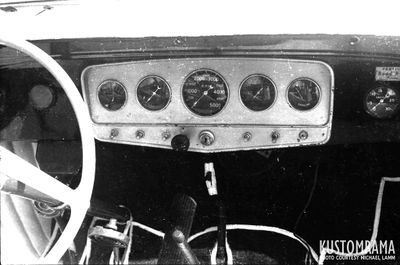Clint Seccombe's 1929 Ford Model A Roadster








1929 Ford Model A Roadster originally built and raced by Throttlers of Hollywood member Clint Seccombe. Seccombe raced the car as early as 1940. By 1946, it had been sold to dry lakes racer Stan Jones, who, according to Jim Miller, modified and shortened the original body. Jones ran the car through 1949.[1]
Sweet 16
In the late 1950s, the old race car resurfaced in the tiny South Texas town of La Blanca, where a kid raced around town with a hot rod that had twice the usual number of cylinders—16 instead of eight. The engine in his 1929 Ford roadster had been donated by a wrecked 1935 Cadillac V-16 sedan.[2]
The kid’s name was Fred Warner Wagers Jr., and he was 18 when Michael Lamm met him in August 1960. He had a girlfriend, Shirley Maxwell, and both attended Edinburg High School. "Fred, who actually went by the name Don, called and asked if I’d like to do an article about his hot rod. I was freelancing at the time, and one of my markets was a New York hot rod magazine called Speed Mechanics."[2]
"I was living in another tiny South Texas town, La Feria, and La Blanca was only a stone’s throw away, so I said sure and hotfooted it down to meet Don, his girlfriend and his car. I was interested in Don’s V-16 because I’d owned a 1932 Cadillac V-16 myself as a teenager, so I wanted to see how Don had managed to cram such a large engine into so small a car. And this particular roadster was even smaller than a stock Model A, because Don had shortened the frame by eight inches and the body by six."[2]
Lamm had heard of other V-16-powered hot rods, but he’d never seen one. "Don had done a nice job of making the engine fit. It tucked back through the cowl, so that the bellhousing stood about a foot behind the newly fabricated firewall. That put the gearshift pretty much dead center in the floor."[2]
"I think it’s appropriate here to talk a little about the first-generation Cadillac V-16. In May 1915, Packard introduced its flathead V-12, and at that time Packard set the standard for upmarket American cars. But by the end of the 1920s, Cadillac decided to pull rank on Packard by developing the nation’s first production V-16. Cadillac launched the V-16 in 1930. Marmon followed in 1931 with its own V-16. Cadillac’s displaced 452 cid and was rated at 165 bhp (later 185), and Marmon’s 491-cid V-16 produced 200 bhp."[2]
The Cadillac V-16 used an aluminum block and pan, iron heads and overhead valves. The V-16 was essentially two straight eights on a common crankcase. Each bank had its own updraft carburetor, two ignition coils, twin points and condensers and a huge common distributor. And the Cadillac V-16 became one of the first American engines—perhaps the first—to use hydraulic valve lifters.[2]
Don told Lamm he’d modified his Cad V-16 by expanding the bores 1/16th inch, giving him 471 cid. "He also had the camshaft ground to “full race,” he said, plus porting and relieving the heads and fabricating new intake manifolds that mounted four to six Stromberg 97 carburetors. Don used four carbs on the street and six for drag racing. Exhaust manifolds were stock, with separate pipes leading into Ford F-8 truck mufflers. Finally, he said, he replaced the hydraulic lifters with solid, adjustable ones. The stock 1935 Cadillac V-16 delivered 185 bhp—one of the top ratings of that era—but Don figured his modded engine put out more like 250 bhp."[2]
"To accommodate the engine, Don had chopped six inches (vertically) out of the roadster doors and welded them shut. He then set the body back on the shortened frame which, he admitted, made for a very tight cockpit. He replaced the Model A gauge cluster with the donor 1935 Cadillac’s instrument panel, substituting a tachometer in place of the speedometer. Transmission was a 1937 LaSalle three-speed, and the 4.11 rear axle came out of a 1940 Ford, as did the hydraulic brakes."[2]
"Suspension used stock Ford transverse springs along with a 1932 Ford front axle dropped three inches but minus any shock absorbers. The rear axle did have tube shocks, angled inward at the top “for stability.” Steering was again 1940 Ford with a lengthened pitman arm for quicker response. Don painted the body white and the frame and 15-inch wheels red. The chromed radiator grille came from a 1937 Ford pickup. Upholstery was Naugahyde, again red and white."[2]
"Don Wagers liked to drag race and entered his roadster at events in San Antonio, Corpus Christi and Uvalde, Texas. His best speed for the quarter mile, he told me, was 114 mph, but somehow I neglected to get the time. I have no idea what eventually became of his 16-cylinder hot rod, nor was I able to locate Don Wagers when I Googled him recently. So all I have are these reminiscences plus the notes and pictures I took nearly 60 years ago."[2]
Fred later got his hot rod into Hot Rod Magazine July 1961, where it was featured in a story written by Mike Lamm.
Magazine Features and Appearances
References
Did you enjoy this article?
Kustomrama is an encyclopedia dedicated to preserve, share and protect traditional hot rod and custom car history from all over the world.
- Help us keep history alive. For as little as 2.99 USD a month you can become a monthly supporter. Click here to learn more.
- Subscribe to our free newsletter and receive regular updates and stories from Kustomrama.
- Do you know someone who would enjoy this article? Click here to forward it.
Can you help us make this article better?
Please get in touch with us at mail@kustomrama.com if you have additional information or photos to share about Clint Seccombe's 1929 Ford Model A Roadster.
This article was made possible by:
SunTec Auto Glass - Auto Glass Services on Vintage and Classic Cars
Finding a replacement windshield, back or side glass can be a difficult task when restoring your vintage or custom classic car. It doesn't have to be though now with auto glass specialist companies like www.suntecautoglass.com. They can source OEM or OEM-equivalent glass for older makes/models; which will ensure a proper fit every time. Check them out for more details!
Do you want to see your company here? Click here for more info about how you can advertise your business on Kustomrama.







